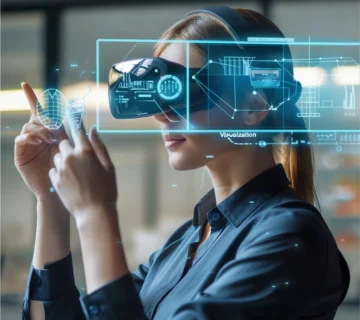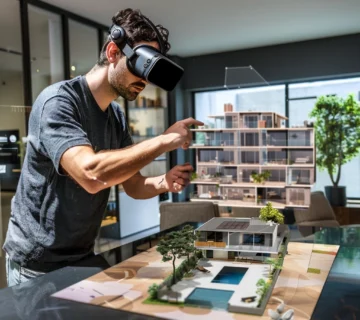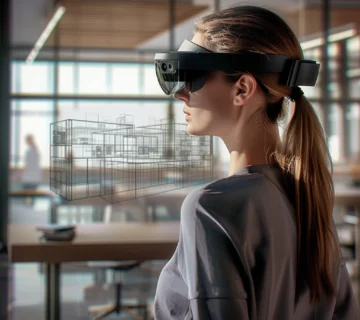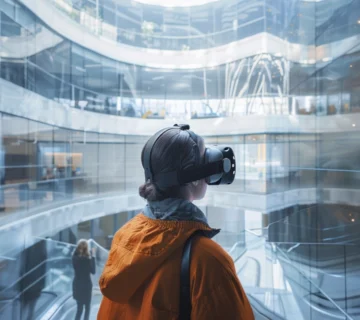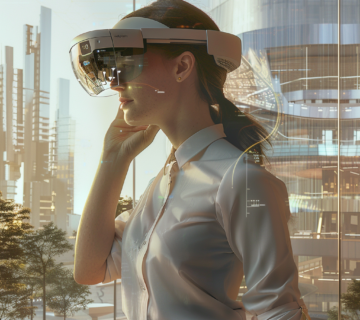Blurring Boundaries: Empowering Visualization Technology in Architecture Design in the Top 2 Styles – Modern and Futuristic.
In the ever-evolving world of architecture, the boundaries of Architecture Design have become fluid, enabling us to explore and push the limits of creativity. This article delves into the dynamic interplay between 2 distinct yet interconnected styles: Modern and Futuristic Architecture Design. At HUUR STUDIOS, we take you on a journey through these architectural domains, where we meticulously examine the subtleties of each style. We illustrate how they come together to reshape the present and carve a path into the future, utilizing state-of-the-art visualization technologies. Explore how these leading styles seamlessly blend, intertwining to leave an indelible mark on the architectural terrain. This exploration opens new horizons for architecture design visualization and presents innovative prospects for the constructed environment.
In the world of architecture design, the possibilities are as vast and dynamic as the urban landscapes they shape. At HUUR Studios, we delve into visualizing the multifaceted realm of architecture design by deploying innovative technology, encompassing not only conventional architectural design but also modern, futuristic, and immersive approaches. Here, Interior Architecture and Exterior architecture coalesce into an Interactive architecture, and Immersive architecture experience. We aim to provide a clear understanding of the meanings of these fundamental concepts—Modern architecture and Futuristic architecture—that we use daily in our studio, as discussed in our other articles.

As we continue to explore the ever-evolving landscape of architecture design, we are driven by the limitless potential for innovation and creativity. These shared disciplines between Modern and Futuristic architecture serve as our guideposts, inspiring us to redefine boundaries and chart a course towards a future where design knows no limits, only endless horizons to explore and dreams to build.
In the upcoming pages, we will explore the shared disciplines within these two architecture design realms in greater depth, offering examples and insights that illuminate the intricate tapestry of Modern and Futuristic architecture. Through our continued exploration, we will reveal how these shared principles facilitate the visualization of architectural concepts that not only stand the test of time but also ignite inspiration for the future of design.
Common Disciplines in Modern Architecture and Futuristic Architecture Visualization
-
Design Principles:
Both Modern and Futuristic architecture share fundamental design principles, such as simplicity, functionality, and a focus on spatial efficiency. The use of clean lines, open spaces, and a minimalistic approach to ornamentation is a hallmark of Modern architecture. Similarly, Futuristic architecture often incorporates sleek, streamlined designs that emphasize efficiency and adaptability. By examining these shared principles, we gain a deeper appreciation for the timeless aspects of architectural design that transcend style and era during the visualization process.

-
Materials and Technology:
In both styles, the choice of materials plays a pivotal role. Modern architecture tends to favor industrial materials like steel, glass, and concrete. Futuristic architecture, on the other hand, often looks to cutting-edge materials and technologies, such as smart glass and carbon-fiber composites. This convergence of tradition and innovation showcases the adaptability of these styles and the willingness to push the boundaries of what’s possible in material usage. Throughout the visualization process, our aim is to generate materials that closely emulate the reality for both architecture design styles.
The blended essence of both styles, showcasing their remarkable versatility and their shared zeal to redefine the very boundaries of material utility and boundless potential. Throughout our meticulous visualization process, we craft materials with dedication to authenticity, ensuring that both Modern and Futuristic architectural designs are resurrected with a genuine touch of reality. Our unwavering commitment to material precision stands as a cornerstone in crafting immersive and true-to-life experiences for the visionary individuals and teams in architectural design, development, and real estate marketing who place their trust in our capabilities. Explore how our collaboration can set your architectural visions soaring.

-
Sustainable architecture Design:
The pursuit of sustainability is a common thread weaving through Modern and Futuristic building architecture. Both styles prioritize environmentally friendly solutions, with Modern architecture often focusing on passive design elements like natural lighting and green roof top designs.

Futuristic architecture leans into advanced sustainability technologies. By examining their shared commitment to eco-conscious design, we uncover a powerful example of how architectural practices evolve while staying true to fundamental values.

-
Integration of Technology:
Technology serves as a driving force in both Modern and Futuristic architecture. Modern architecture designs incorporate technology by incorporating smart home features and energy-efficient systems. Futuristic architecture, on the other hand, goes a step further by integrating augmented reality, virtual reality, and artificial intelligence into its structures. As we delve into the synergy between technology and these styles, we witness the ongoing evolution of the relationship between architecture and the digital age. Digital architecture plays a crucial role in providing innovative visualization technologies for both design styles.

-
Human-Centered Design:
“Human-centered design is a practice where designers focus on four key aspects. They focus on people and their context. They seek to understand and solve the right problems, the root problems. They engage in testing and improving their products and services to guarantee that their solutions effectively address the requirements of their targeted audience.” [Reference]
Both Modern and Futuristic architecture design share a focus on designing spaces that cater to inhabitants’ needs and experiences. Modern architecture prioritizes functionality and comfort, aligning with Futuristic architecture’s mission to create immersive and adaptive environments. These approaches converge in the pursuit of interactive architectural designs that not only impress but also enhance the quality of life for those who dwell within. We strive to infuse this human-centric approach into every project we visualize.
-
Adaptive Design:
A core discipline that unites Modern and Futuristic architecture is adaptability. Modern architecture often focuses on designing spaces that can easily transform to accommodate changing needs and lifestyles. Futuristic architecture takes adaptability to the next level, with exterior architecture design and structures that can reconfigure themselves based on user preferences and real-time data. This shared emphasis on adaptability underscores the importance of creating spaces that can evolve with the dynamic demands of the modern world.
-
Interplay of Light and Space:
Both styles place a strong emphasis on the interplay of light and space. Modern architecture often utilizes large windows, open floor plans, and natural light to create a sense of openness. Futuristic architecture explores advanced lighting technologies, holographic displays, and dynamic spatial configurations. The fusion of these concepts underscores the enduring relationship between how light and space interact to shape the built environment.
-
Cultural and Contextual Sensitivity:
A shared discipline is the consideration of cultural and contextual factors. Modern architecture often adapts to its surroundings by using materials and design elements that reflect local culture and history. Futuristic architecture builds on this by integrating technology that respects and adapts to the cultural and contextual elements of a location. This approach bridges the past and the future, ensuring that architectural designs remain relevant and respectful of their environment.
-
Visual Storytelling:
Both styles understand the power of visual storytelling. Modern architecture uses clean, clear lines to communicate a sense of purpose and functionality. Futuristic architecture leverages advanced visualization techniques, such as augmented reality, to convey narratives and immersive experiences. The synergy between these architecture design styles highlights how architecture can tell compelling stories, taking us beyond the realm of mere functionality.
-
Sustainability and Innovation:
The commitment to sustainability and innovation runs deep in both Modern and Futuristic architecture. Modern architecture, with its emphasis on eco-friendly building practices, laid the foundation for Futuristic architecture to push the boundaries even further by integrating cutting-edge sustainability solutions and technologies. This shared pursuit of a sustainable future through innovative design demonstrates the enduring influence these styles have on the architectural world.
As we navigate the intricate balance between architecture design styles in both Modern and Futuristic disciplines, it becomes clear that these styles are not mutually exclusive but rather interconnected. Their shared values and principles form the foundation upon which the evolving landscape of architecture is built. Join us in the next section as we explore how these disciplines manifest in the visualization of architectural designs, and how they continue to inspire us to push the boundaries of what’s possible in the world of architecture.
Conclusion:
Pushing architecture design Boundaries and Forging the Future of visualization
In our exploration of the common disciplines that underpin Modern and Futuristic architecture, we’ve uncovered a fascinating interplay between tradition and innovation. These two distinct styles are not isolated entities but rather interconnected facets of architectural design. They share core principles such as sustainability, adaptability, and human-centered design, while simultaneously embracing advanced technologies and materials.
The beauty of this intersection lies in its ability to shape the architecture of today and tomorrow. Modern and Futuristic architecture complement each other, creating a rich tapestry of design possibilities. Together, they push the boundaries of what’s possible, weaving a narrative that transcends time and inspires us to think beyond convention.
As we look to the future, these shared disciplines provide a roadmap for architects and designers to create spaces that are not only visually stunning but also sustainable, adaptable, and deeply meaningful to the people who inhabit them. This architecture design journey, where Modern meets Futuristic, reminds us that, in the world of design, there are no limits—only horizons to explore, ideas to innovate, and dreams to build.



